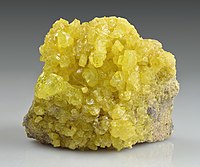
Photo from wikipedia
Abstract Dimethylsulfide (DMS) and dimethyldisulfide (DMDS) are precursors to products, like sulfuric acid and methanesulfonic acid (MSA), which are important to secondary aerosol formation. The formation and yields of particulate… Click to show full abstract
Abstract Dimethylsulfide (DMS) and dimethyldisulfide (DMDS) are precursors to products, like sulfuric acid and methanesulfonic acid (MSA), which are important to secondary aerosol formation. The formation and yields of particulate MSA and sulfuric acid from the oxidation of reduced sulfur compounds is not well understood. In this study, a 37.5 cubic meter Teflon environmental chamber was utilized to study the oxidation mechanism and aerosol forming potential of DMS and DMDS under dry conditions. Experiments were conducted in both the presence and absence of N O x , using hydroxyl radical, nitrate radical, as well O ( P 3 ) as an oxidant. With initial N O x concentrations of 100 part-per-billion, relatively low for laboratory oxidation experiments, O ( P 3 ) dominated oxidation of the reduced sulfur precursor and resulted in aerosol mass yields of greater than 40%. Hydroxyl radical oxidation of DMS and DMDS in the absence of N O x resulted in aerosol yields of 6% and 13%, respectively, while nitrate radical oxidation in the presence of N O x resulted in yields of 8% and less than 1%, respectively. Evidence of sulfuric acid formation was present during all particle-forming experiments, as was evidence of additional unknown sulfur-containing organic particulate. There was no evidence of MSA formation in the gas- or particle- phase throughout this study. The absence of MSA formation in the presence of N O x has not been reported in previous studies and indicates a lack of understanding of the MSA formation mechanism. The observations made during this chamber study diverge from observations made during previous studies conducted under high precursor and N O x concentrations, emphasizing the importance of atmospherically relevant initial conditions
Journal Title: Atmospheric Environment
Year Published: 2021
Link to full text (if available)
Share on Social Media: Sign Up to like & get
recommendations!